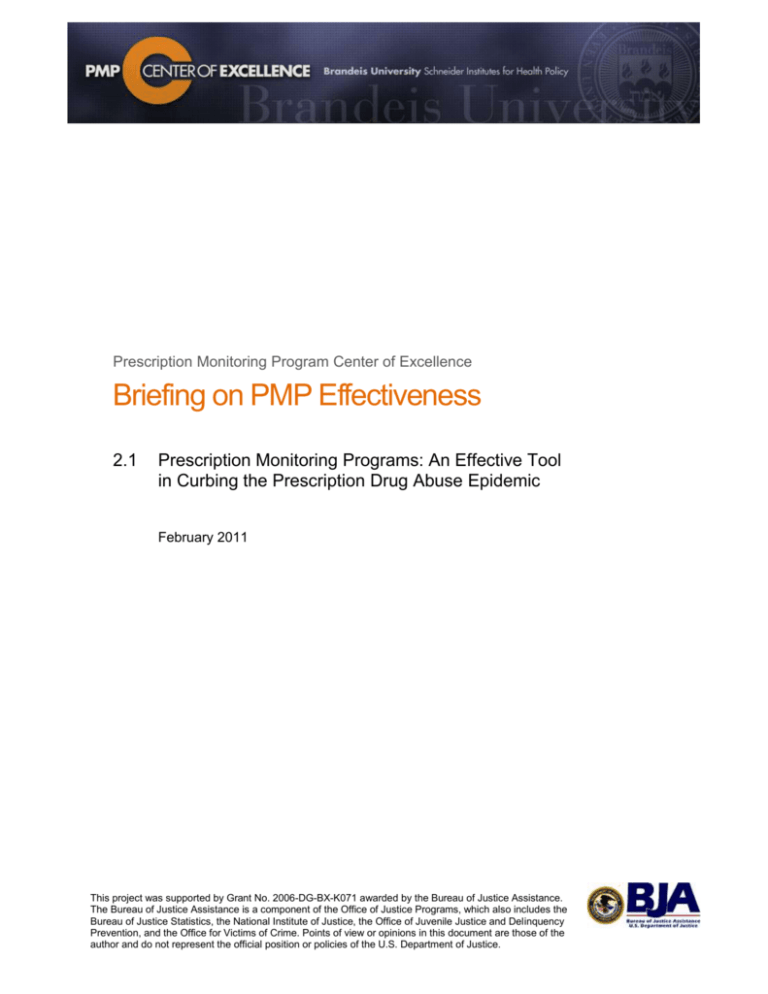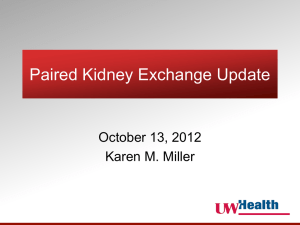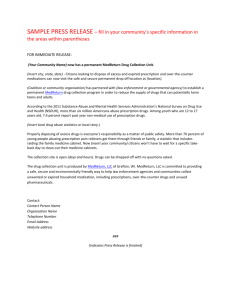Briefing on PMP Effectiveness
advertisement

Prescription Monitoring Program Center of Excellence Briefing on PMP Effectiveness 2.1 Prescription Monitoring Programs: An Effective Tool in Curbing the Prescription Drug Abuse Epidemic February 2011 This project was supported by Grant No. 2006-DG-BX-K071 awarded by the Bureau of Justice Assistance. The Bureau of Justice Assistance is a component of the Office of Justice Programs, which also includes the Bureau of Justice Statistics, the National Institute of Justice, the Office of Juvenile Justice and Delinquency Prevention, and the Office for Victims of Crime. Points of view or opinions in this document are those of the author and do not represent the official position or policies of the U.S. Department of Justice. Briefing on PMP Effectiveness Prescription Monitoring Programs: An Effective Tool in Curbing the Prescription Drug Abuse Epidemic Summary Evidence is accumulating that prescription monitoring programs (PMPs) are effective in reducing diversion of controlled substances and improving clinical decision-making, thus helping to curb the prescription drug abuse epidemic. The Prescription Drug Abuse Epidemic Addiction, overdoses and deaths involving non-medical prescription drug use, especially narcotic pain relievers, have risen dramatically over the last decade, surpassing those due to illicit drugs such as heroin and cocaine. According to conservative estimates, costs in the U.S. related to prescription opioid drug abuse in 2001 totaled $8.6 billion; they have undoubtedly risen since then.1 More information regarding the epidemic is available on the PMP Center of Excellence website.2 The Role of Prescription Monitoring Programs (PMPs) Currently there are 43 states and one US Territory with legislation that establishes a PMP. Thirty-four states have operational PMPs and several will become operational in 2011. PMPs collect data from pharmacies on dispensed controlled substance prescriptions. PMPs are important tools in the effort to curb major sources of prescription drug diversion: prescription fraud, forgeries, doctor shopping3 and illicit, medically unwarranted prescribing on the part of some practitioners and pharmacists. PMPs therefore serve an essential function in combating the prescription drug abuse epidemic. More information on PMPs is available on the Alliance of States with Prescription Monitoring Programs website.4 Below, a sampling of reports and studies is presented to demonstrate that PMPs can play a role in reducing diversion of controlled substances, saving lives and taxpayers’ money. States without PMPs are more likely to experience higher rates of controlled substance diversion An independent evaluation of Kentucky’s PMP noted that in 2006, distribution of oxycodone was highest in Florida compared to other states on interstate Route I-75, while distribution of hydrocodone was highest in Tennessee. Since 2004, oxycodone distribution in Kentucky, a state with a well-established prescription monitoring program, rose at a much lower rate than in either Florida or Tennessee, neither of which had active PMPs during this period.5 Florida, still without a PMP, is home to hundreds of storefront pain clinics (“pill mills”) that supply Southeastern states with millions of doses of medically unwarranted prescription drugs. States with PMPs use PMP data to improve clinically appropriate prescribing and reduce doctor shopping A study of medical providers in Ohio emergency departments found that 41% of those given PMP data altered their prescribing for patients receiving multiple simultaneous narcotics prescriptions. Of these providers, 63% prescribed no narcotics or fewer narcotics than originally planned, while 39% prescribed more. This indicates that PMP data can help inform sound clinical decision-making to insure prescriptions are medically necessary, reducing illicit use of controlled substances.6 2 PMP Center of Excellence at Brandeis University www.pmpexcellence.org Briefing on PMP Effectiveness In California, 74% of physician responders to a survey indicated they had changed their prescribing practices to a patient as a result of using PMP Patient Activity Reports (PAR), and 91% rated the “effectiveness of the PAR in maintaining the care and health of your patient” as good to excellent.7 A 2010 survey of users of Kentucky’s PMP, Kentucky All Schedule Prescription Electronic Reporting (KASPER), found that PMP reports were an aid to clinical practice, with 70% of prescribers and dispensers judging them “very” or “somewhat” important in helping them decide what drug to prescribe a patient.8 The survey also found that nearly 90% of prescribers and pharmacists responding to the survey “refused to prescribe or dispense a controlled substance based on the information contained in a KASPER report.” In September 2008, Louisiana informed pharmacies to begin submitting data to the new PMP on January 1, 2009, including an identification number from persons picking up prescriptions. Many pharmacies then began requiring customers to show ID, to record the numbers, and to inform customers about the new policy. Five doctor shoppers who each obtained an average of 16.9 controlled substances prescriptions per month prior to September dropped to 0 prescriptions by December. Louisiana attributes this important change to the PMP implementation.9 An analysis of Wyoming’s PMP indicates that as prescribers and pharmacists received unsolicited PMP reports concerning likely doctor shoppers, and as they requested more reports on patients, the number of likely doctor shoppers showing up in the PMP database declined. This indicates that PMP reports prompt prescribers and pharmacists to reduce the availability of controlled substances to patients engaged in doctor shopping, reducing costs related to prescriptions, addiction, and abuse.10 As the Massachusetts PMP began sending unsolicited PMP reports regarding possible doctor shoppers to prescribers in 2010, prescribers were asked about the usefulness of the reports. Of the first 162 responders, only 14% said they were “aware of all or most of other prescribers,” and only 13% said “based on current knowledge, including the report, the patient appears to have legitimate medical reason for prescriptions from multiple prescribers.” This indicates that proactive reporting of PMP data alerts prescribers about possible doctor shopping, which in turn can inform their prescribing practices.11 States that proactively analyze and distribute PMP data have smaller increases in the availability of prescription drugs, with lower rates of treatment admissions A national evaluation comparing states with and without PMPs and focusing primarily on Schedule II controlled substances found that proactive PMPs were associated with slower growth in the per capita availability of prescription pain relievers and stimulants, as well as lower rates of treatment admissions for abuse of these drugs.12 States with PMPs have smaller increases in opiate exposures related to abuse and misuse 3 A national analysis of poison center data found that in states with PMPs, calls concerning intentional exposures to opiates (an indicator of opiate abuse or misuse) rose just 1.0% annually, while in states without PMPs these calls rose at an annual rate of 7.9%.13 PMP Center of Excellence at Brandeis University www.pmpexcellence.org Briefing on PMP Effectiveness PMP data assist in investigations of drug diversion, reducing investigation times A 2010 survey found that nearly three quarters (73%) of law enforcement officers who used Kentucky’s PMP (KASPER) strongly agreed that “KASPER is an excellent tool for obtaining evidence in the investigative process.” 14 A 2002 Government Accounting Office report showed that the average times for investigations of doctor shoppers in Kentucky dropped from 156 days to 16 days after implementation of KASPER. The same report found that average investigation times for doctor shoppers dropped markedly following the implementation of Nevada’s PMP, from 120 days to 20 days, reducing expenses related to investigations.15 Participants in 2010 National Law Enforcement PMP Meeting concurred unanimously that PMPs are an important law enforcement tool. PMPs can reduce costs of law enforcement and help monitor compliance and abstinence Nevada’s Pre-Criminal Intervention Program uses PMP data to identify, enroll, and monitor individuals to help them stop doctor shopping, making law enforcement involvement unnecessary and saving taxpayers the cost of investigations, prosecutions and incarceration.16 Drug courts in Kentucky use PMP data to help monitor abstinence from prescription drugs, helping clients achieve sobriety and stability, thus improving the court’s ability to assure compliance and reducing costs related to drug diversion and abuse.17 Substance abuse treatment programs in Maine consult PMP data when admitting patients into treatment (patient consent required) to help validate patient self-reports on use of medications.18 A report from the Medical Director of an opioid addiction treatment program indicates that PMP data are an important clinical tool in monitoring use of controlled substances by patients addicted to opioids, keeping patients safe and increasing the effectiveness of treatment.19 PMP data show promise in assisting drug abuse prevention efforts The PMP Center of Excellence is developing methods to analyze PMP data to identify doctor shopping hot spots that can help state and community drug abuse prevention organizations target their interventions for maximum impact.20 Physicians express support for Prescription Monitoring Programs 21 4 “This has been a huge benefit for our clinic and managing Pt’s narcotic use. It has improved our clinic and our time required for calling all the Pharmacies in the area to find out if our Pt’s are being compliant with medications and weed out those who are not, to provide for those Pt’s who really need our care.” – Mississippi Pain Management Specialist PMP Center of Excellence at Brandeis University www.pmpexcellence.org Briefing on PMP Effectiveness “We would like to take the time to express our gratitude for all your efforts in the CURES program. This program is a wonderful resource tool in tracking our controlled substance prescriptions and aiding in prevention of substance abuse.” – California Pain Management Specialist. “As an emergency physician, I have found the OARRS program [Ohio PMP] extremely useful. I am shocked daily by the number of prescriptions and prescribers that some of my patients possess.” - Ohio Physician “I appreciate this website greatly!!! As a hospitalist it makes my life much easier to verify drug history and doctor shoppers.” – Ohio Physician “Instant access to controlled substance history is critical to safe management of patients.” – Massachusetts Physician22 Investigators find PMPs an invaluable resource 23 “As far as enforcement of the Controlled Substance Act, Prescription Monitoring Program is one of the best assets we have ever had. The countless hours saved by the Agents being able to pull the profile compared to the way Agents used to have to go to each pharmacy to get a profile have saved the State a large amount of money in salaries and vehicle expense.” - Agent, Mississippi Bureau of Narcotics “This database is like cell phones and e-mail - what the heck did we do without it?” Pharmacy Diversion Investigator, Ohio Narcotics Agency "... the monitoring system in MS has been great. It has helped me identify alleged over prescribing registrants, possible doctor shopping patients, as well as possibly impaired practitioners writing prescriptions for themselves.” - DEA Diversion Investigator “After receiving a complaint, I can request a report and know in just a few minutes if there is a case to investigate or not… I cannot say enough about KASPER and how valuable it is in my day to day investigations. If you, as an investigator, are not utilizing KASPER, you are limiting your resources and missing valuable information.” – KY State police officer24 *********** Note: For inquiries concerning this report, please contact the PMP Center of Excellence at Brandeis at http://www.pmpexcellence.org or call 781-736-3909. 5 PMP Center of Excellence at Brandeis University www.pmpexcellence.org Briefing on PMP Effectiveness Endnotes 1 Birnbaum HG, White AG, Reynolds JL, Greenberg PE, Zhang M, Vallow S, Schein JR, Katz NP. 2006. "Estimated costs of prescription opioid analgesic abuse in the United States in 2001: a societal perspective." Clinical Journal of Pain. 22(8):66776. And see Baldasare, A. 2011. “The cost of prescription drug abuse: a literature review.” White paper for SAI LLC, http://sai-dc.com/resources/view/?doc=20110106-cost-of-prescription-drug-abuse 2 See the PMP Center of Excellence page on the prescription drug abuse epidemic at http://www.pmpexcellence.org/drugabuse-epidemic Doctor shopping, punishable by law in some states, is commonly understood as an individual’s obtaining prescriptions from multiple prescribers and pharmacies without revealing to each prescriber and pharmacy that the others are involved. 3 4 See the FAQ on PMPs at the Alliance of States with Prescription Monitoring Programs at http://www.pmpalliance.org/content/prescription-monitoring-frequently-asked-questions-faq K. Blumenschein et al., “Independent evaluation of the impact and effectiveness of the Kentucky All Schedule Prescription Electronic Reporting Program (KASPER),” 2010, http://www.chfs.ky.gov/NR/rdonlyres/24493B2E-B1A1-4399-89AD1625953BAD43/0/KASPEREvaluationFinalReport10152010.pdf 5 D. Baehren et al., “A statewide prescription monitoring program affects emergency department prescribing behaviors,” Annals of Emergency Medicine, 2009, http://www.ncbi.nlm.nih.gov/pubmed/20045578 6 Alliance of States with Prescription Monitoring Programs, “An Assessment of State Prescription Monitoring Program Effectiveness and Results” Version 1, 11.30.07, http://pmpexcellence.org/pdfs/alliance_pmp_rpt2_1107.pdf 7 8 Kentucky Cabinet for Health and Family Services and Kentucky Injury Prevention and Research Center, 2010 KASPER Satisfaction Survey, http://chfs.ky.gov/NR/rdonlyres/BDC0DFC9-924B-4F11-A10A5EB17933FDDB/0/2010KASPERSatisfactionSurveyExecutiveSummary.pdf 9 Communication from LA PMP to PMP Center of Excellence dated 2/1/2010 – report forthcoming PMP Center of Excellence, “Trends in Wyoming PMP prescription history reporting: evidence for a decrease in doctor shopping?” 2010, http://www.pmpexcellence.org/sites/all/pdfs/NFF_wyoming_rev_11_16_10.pdf 10 11 P Kreiner of the PMP Center of Excellence communication to MA PMP regarding preliminary analysis of baseline survey. R. Simeone and L. Holland, “An evaluation of prescription drug monitoring programs,” Simeone Associates, Inc., 2006, http:// www.simeoneassociates.com/simeone3.pdf. See also “State prescription monitoring programs highly effective,” Carnevale Associates, 2007, http://www.pmpexcellence.org/pdfs/pdmp_info_brief2.pdf 12 L.M. Reifler et al., “Reduction over time in RADARS system poison center opioid misuse/abuse rates associated with prescription monitoring programs,” American Public Health Association poster session 218163 RADARS® System; November, 2010. http://rmpdc.org/Portals/23/Poster%20PC%20rates%20for%20PMP-LAOs%2015SEP10.pdf 13 14 Kentucky Cabinet for Health and Family Services and Kentucky Injury Prevention and Research Center, 2010 KASPER Satisfaction Survey, http://chfs.ky.gov/NR/rdonlyres/BDC0DFC9-924B-4F11-A10A5EB17933FDDB/0/2010KASPERSatisfactionSurveyExecutiveSummary.pdf GAO Report GAO-02-634: “Prescription drugs. State monitoring programs provide useful tool to reduce diversion,” 2002, http://www.gao.gov/new.items/d02634.pdf 15 PMP Center of Excellence, “Staying clear of the law and addiction: Nevada’s pre-criminal intervention program,” 2011, http://www.pmpexcellence.org/sites/all/pdfs/2_nevada_pcip_nff_1_19_11.docx 16 17 Communication from KY Drug Court Judge – report forthcoming 18 Communication from ME PMP – report in development 19 Communication from the Medical Director of the opioid addiction treatment program – report forthcoming “The Prescription Drug Abuse Epidemic and Prevention: How Prescription Monitoring Programs Can Help," PMP Center of Excellence webinar presentation for the Center for the Application of Substance Abuse Technologies, http://www.pmpexcellence.org/sites/all/pdfs/pmp_subst_abuse_prevent_web_09_23_10.pdf 20 21 Alliance of States with Prescription Monitoring Programs, op. cit. 22 Communication from MA PMP to PMP Center of Excellence 2/17/2011 23 Alliance of States with Prescription Monitoring Programs, op. cit. 24 Text of remarks regarding Kentucky All Schedule Electronic Reporting (KASPER) System from video made in Kentucky, August 2005, http://www.pmpexcellence.org/sites/all/pdfs/kasper_video_trans_marshall_2005_08_a.pdf 6 PMP Center of Excellence at Brandeis University www.pmpexcellence.org







